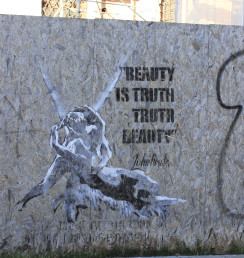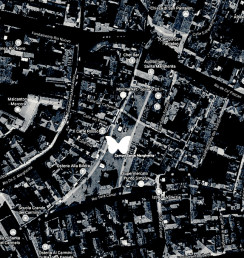The journey of a work of art from Toronto to Venice
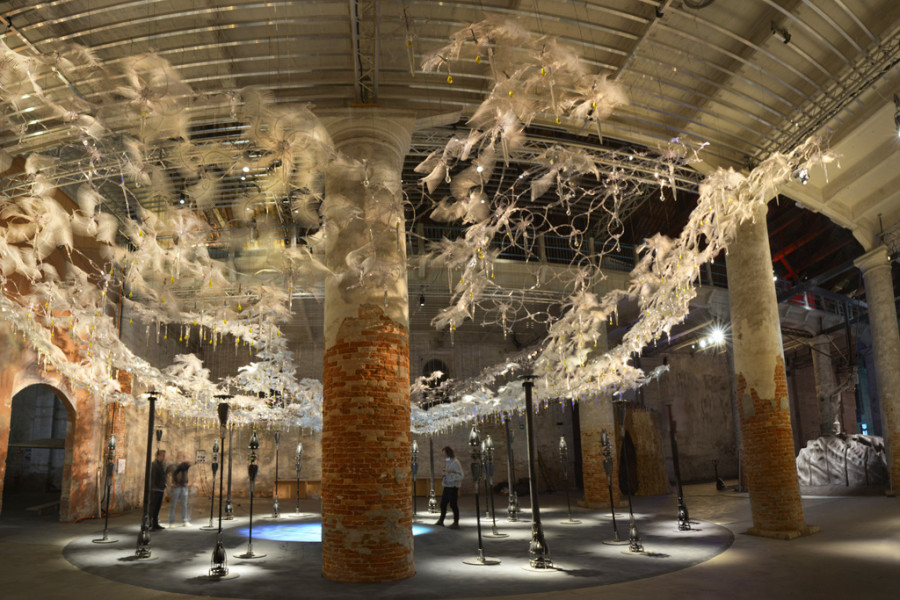
We continue our journey of discovery of the Grove installation, a metaphor for new spaces to live in and an evolution of the human species towards the creation of hybrid beings in close connection with both technology and the environment, understood as plants, animals, but also as minerals and inert beings!
If you missed the first interview with Philip beesley - architect, visual artist and director of >>>Living Architecture Systems Group in Waterloo, Canada and author of Grove Installation at the Biennale Architettura 2021 - >>>you can read it here.
Today we will explore the point of view of Sascha Hastings – very skilled curator and art producer, and a very nice person – who followed the complex process of moving Grove from Canada to Venice: an adventure further complicated by the arrival of the global pandemic in 2020.
Interview with Sascha Hastings
Maddalena Mometti: First of all, I would like to ask you to tell me about the genesis of the adventure and all the stages of organisation required to get Grove Installation to Venice, please.
Sascha Hastings: In the early fall of 2019 Hashim Sarkis invited Philip Beesley and Living Architecture System Group to the Venice Biennale. At that time Philip contacted me about being involved as I had worked with him on his 2010 installation at the Canada Pavillion and on other Canadian exhibitions at the Biennale.
He was working on an exhibition in Cambridge, called >>> Meander which included an immersive distributed soundscape developed in collaboration with the Netherlands-based group >>> 4DSOUND .
And we had the idea of linking the new Venice installation to Meander, to create a connection between the two pieces of art. We imagined a very interactive installation. So we came to Italy in January 2020 for a site visit and meetings with the Biennale in order to understand how to make this possible and to plan the construction of the installation.
But then we started hearing news about the pandemic and at the end of February 2020 Italy was in lockdown. So we asked the Biennale organisers what they thought was going to happen. They assured us that the Biennale would still take place as planned.
Unfortunately, the pandemic progressed rapidly and we were told in March that the Biennale would be postponed until a date to be determined.
So we started to ask ourselves some important questions:
_ can we afford to continue working on the project, considering that postponing it even by six months was a major investment in terms of time and costs?
_ can we propose the same type of installation in a context where social distancing is required?
We decided to modify the exhibition in order to fit the new situation of social distancing and we started thinking about what we would do if the Biennale would be transformed into a digital-only event.
And the idea that came to our minds was to reduce the physical density of the installation while dramatically enhancing the use of sound to create extensive sound piece and to design custom speakers. We also decided to branch out into film as major new component of our work.Through Philip’s previous collaboration with avant-garde Dutch fashion designer Iris Van Herpen, he had met the very skilled British filmmakers Warren Du Preez and Nick Thornton-Jones. They showed us some CGI [Computer-generated imagery films]films they had already created: they were completely amazing!
We decided that together with Warren and Nick, we would use the new Venice work to convey the idea of life coming from death, to give a message of hope during difficult times.
We started to work with the filmmakers. We sent them digital files of Philip’s physical work and they transformed them into computer graphics.
In the meantime the composer, Salvador Breed, and sound designers, 4DSOUND, started creating the sound component.
Warren, Nick and Salvador worked together to create a film and sound experience that meld together seamlessly, like they are one thing.
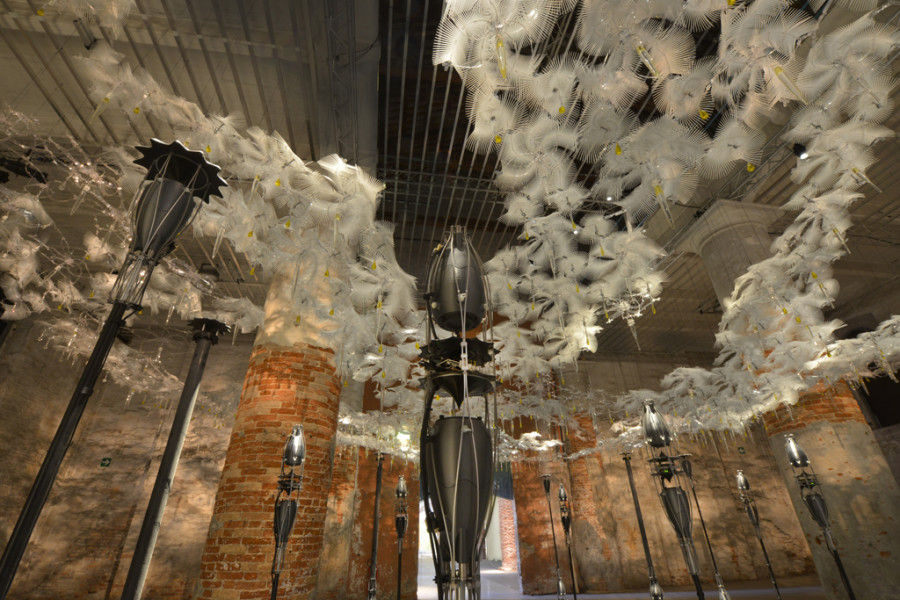

The installation team
Maddalena Mometti: What about your collaboration with the Conservatorio di Musica di Vicenza “Arrigo Pedrollo”?
Sascha Hastings: It was a wonderful collaboration! We were so lucky! When I was in Venice in January 2020, after meeting you Maddalena, I also met some other friends and contacts to potentially work with. We already knew we needed to find a very skilled local installation team that also specialized in audio/video but of course, at that time, we didn’t realize how heavily we would come to rely on them because of the pandemic.
Some friends who are pioneers in he filed of Interaction Design introduced me to Davide Tiso, a sound designer and professor at the conservatory. And then Davide managed to involve twenty-one of his students in our project.
The Biennale was also very supportive and provided four Academia students. Davide coordinated the whole installation team, with some help from two of our colleagues.
It was really incredible! The students were very dedicated and enthusiastic to be involved in our project. I think they were particularly excited because they hadn’t had a chance to do any practical things for a whole year (because of the lock down period).
In spite of all the difficulties due to Covid-19 restrictions – masks, regular molecular testing, etc. – the students came days after days to help us with great generosity and commitment. We were really lucky to have had them on our team! I really want to thank them again!
Normally, when Philip’s studio does an installation, we send a large team that has experience installing his work, because it is quite complex. This time we had to improvise because of travel restrictions. It went like this: we flat-packed the pieces of the installation in crates and sent them from Toronto to Venice. The students then assembled the installation’s physical “cloud” component and the speakers, under the guidance of Davide and two of our former colleagues who were able to travel to Venice to assist. While the Biennale built the concave floor screen for the projection of the film.
At that point another new local colleague, Amerigo Piana, joined the team to help us adjust and synchronize the sound, film and lighting on site. One of the conservatory students continued to collaborate with us throughout the Biennale, by regularly checking that the technical equipment (speakers, etc.) was still set up and working correctly.
It was quite an adventure for our studio to coordinate the installation team remotely, from so far away and with six-hours time difference. But our colleagues in Venice were fantastic! At the end of each day they sent us photographs and notes of what they had done, and then Philip and our studio tech team gave them instructions for the next day. Of course we also had lots of video calls – thank goodness for Whatsapp!
Maddalena Mometti: What was the best moment of this adventure?
Sascha Hastings: There were several very emotional moments. One was when we figured out how to make the installation possible despite the pandemic by modifying the initial design of the project to focus more on the non-physical components — sound and film. We realized that we could deliver a great installation, whether the Biennale happened in real life or was only virtual. Another moment was when we saw the first preview of the film. It was simply breathtakingly beautiful and astonishing to see Philip’s work come to life in film.
But for me the most amazing moment was when I first saw the complete installation up and running. We almost couldn’t believe it after all the setbacks and challenges. There were times it had felt like maybe it was impossible to do with Covid-19. But we persevered and we did it!
This adventure has been a miracle!
What it means to be a curator
Maddalena Mometti: Can you tell me more about your job as curator?
Sascha Hastings: I started my career completely by accident. I studied Renaissance Studies and German Literature in Toronto and Germany. I knew I wanted to work in the arts and culture world but I didn’t know where and how yet.
Then I got an internship at CBC Radio, where I started doing research for the flagship national arts program, and then gradually I learned how to produce interviews for the radio! It was amazing training for curatorial work: in radio you have to tell coherent and interesting stories to an audience that is curious and intelligent but doesn’t necessarily know about the specific art topic in detail. I learned a lot about how to present and tell stories to diverse audiences and about arts in Canada, and around the world in general.
Being a curator is very similar to being a radio producer, only your medium is more visual than verbal. You still have to tell interesting stories to people and keep them engaged. As a curator, I see myself as a kind of conduit or editor between the artist and the public. My role is to translate and transmit the artist’s work to the public in the best possible way.
About Venice
Maddalena Mometti: What brought you to Venice in the first place?
Sascha Hastings: Years ago I produced a radio interview with some Canadian artists who were doing the Canada Pavillion at the Venice Art Biennale and I thought: “This is so cool! One day I want to work on the Venice Biennale!”. Then a few years later I had the chance to work with Philip Beesley on his exhibition for the 2020 Canada Pavillion – that was my first Biennale experience.
Since then I have worked on five Canadian exhibitions at the Biennale, and even lived in Venice for a year. I really love Venice!
>>> Vai all’intervista con Philip Beesley!
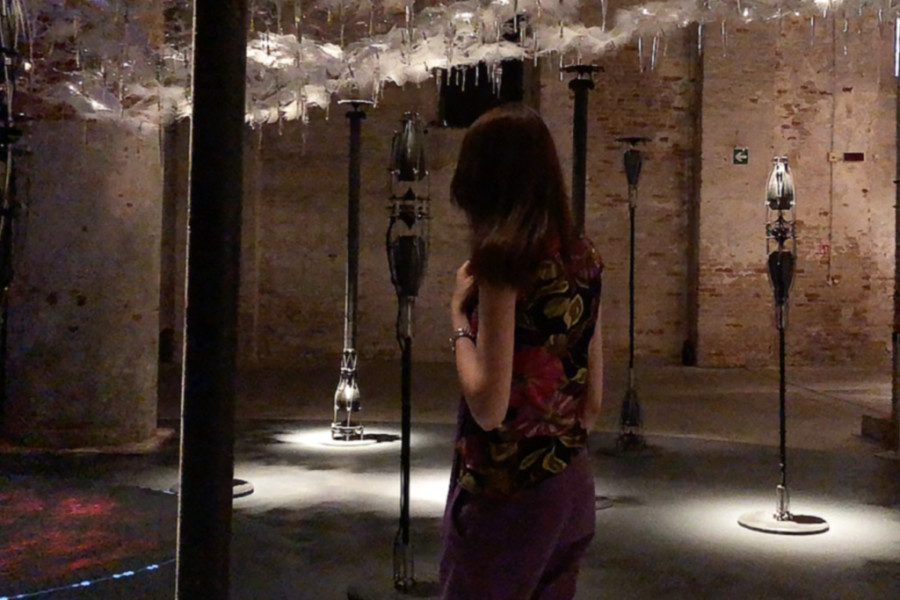
Other posts on new fashion scenarios:
>>> A new architecture for a new kind of human beings Interview with Philip Beesley
>>> Fashion is design Il ritorno della Moda con la “M” maiuscola a Venezia
>>> Digital Glamour: when fashion opens up new worlds “Digital as the fifth element, in addition to air, water, earth and fire” by Chic Words
>>> Green Carpet Fashion Awards 2020 “What we wear speaks to who we are and what be believe in” Robert Downey
IMAGES
All photos are courtesy of Philip beesley and Sascha Hastings.
Starting from the top:
[images 1,2] Grove installation photos
[image 3] The students who did the installation
[image 4] Chic Words visiting the Grove installation

